Automation of warehouse processes of an online store: the experience of Audiomania - Part 1
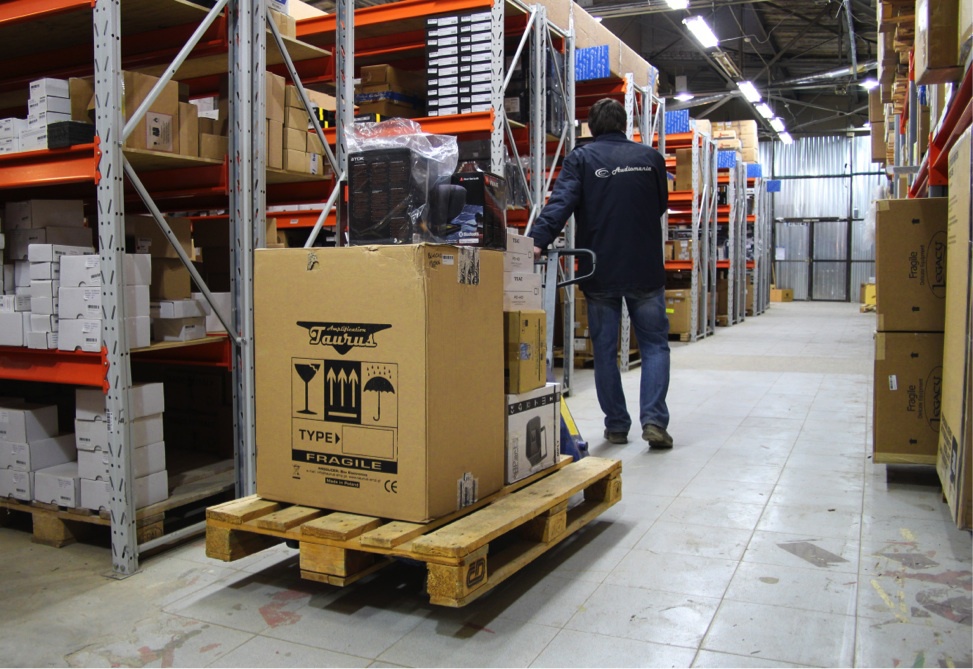
One of the main pain points of most online stores is the warehouse. Maintaining it is quite expensive, but even if you have a warehouse, it is extremely difficult to properly organize its work. We at Audiomania ourselves faced many of the complexities of warehouse logistics and developed a number of approaches that can effectively solve the most common warehouse problems.
Problems
First you need to break down the general problem called “warehouse logistics” into smaller ones. The first thing we faced was that the warehouse employees often had too much responsibility: they had to make decisions related to how and where to put the goods, how to group them, what and where to store them. Accordingly, when one of them was absent, serious difficulties began - after all, many of these decisions were made individually by employees. We at Audiomania sell audio products, among which there are not only large speaker systems, but also rather small radio components, which were simply unrealistic to find if, for example, the employee who took them to the warehouse suddenly became ill.
From this problem the second smoothly flowed - in fact, the search for goods in the warehouse. Very often, an online store is faced with the following situation: there is an accurate understanding that the product is in stock, but nobody knows where exactly it is located (often simply because there is no person accepting this product in the warehouse at the time of the search). Often, such confusion and personal responsibility of the storekeepers lead to reassortment (situations when the client receives the wrong or not quite the goods that he originally ordered): for example, once a lot of headphones came to our warehouse, marked with the abbreviation “BL”. As a rule, black goods are marked this way, but this time under “BL” the manufacturer meant “blue” - “blue”. As a result, many customers received headphones of a different color,
Tasks
At some point (by the summer of 2012), all this confusion had accumulated so much fatigue that it was decided to take up the restructuring of the warehouse more closely. The main engine of progress in this case was the rapid growth of the company - we developed at such a rate that it was impossible to solve the problem by an extensive increase in the number of storekeepers. Among the main tasks of this process, the following were highlighted:
- Elimination of regrowth;
- Increase in labor productivity;
- Providing easy and fast scalability;
- Accelerating the training of new employees;
- Creating a flexible system for controlling goods in stock.
Decision
Storekeeper software and equipment
As part of the warehouse optimization, we wrote software that allows us to automate the work of storage facilities and simplify the tasks of storekeepers (given that all software development and support is carried out within the company, we have no problems exchanging data and working with them). The software continues to improve, but the main work on writing it took three months (including preparation). During the preparation, we went to the logistics centers of partner companies, studied their experience. After that, a team of several people, including the technical director, the head of the development department and the warehouse manager, developed the ToR, which was received by our full-time programmer (he was directly involved in writing the code).
There were two reasons why we created our solution, but did not take advantage of existing ones:
- The need to use and maintain software written for legacy platforms ( most warehouse terminals use software written for the Windows Mobile platform). For example, the top warehouse terminals from Motorola and now work under Microsoft Windows CE 5.0 Professional Version.
- The high cost of equipment. We reasonably wanted to reduce the cost of our warehouse terminals compared to ready-made solutions: a regular terminal costs from several tens to one hundred thousand rubles (on average, a warehouse terminal costs about 35,000 rubles, large logistics centers use terminals worth about 50,000 rubles). At the same time (see paragraph 1) for this money, devices with the same slow and obsolete operating system are offered on the market for this money.
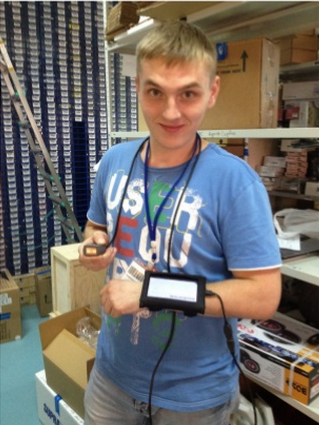 Even the main advantage of the industrial terminal - resistance to shocks and falls - was not of any serious importance for us: according to our calculations, even if we break down one “custom” terminal per week, the costs (on the scale of several years of working with the “national teams” »By terminals) will be lower than when purchasing specialized solutions.
Even the main advantage of the industrial terminal - resistance to shocks and falls - was not of any serious importance for us: according to our calculations, even if we break down one “custom” terminal per week, the costs (on the scale of several years of working with the “national teams” »By terminals) will be lower than when purchasing specialized solutions. However, the “prefabricated” version of the warehouse terminal also turned out to be fraught with “pitfalls”. In the photo (left) you see the initial version of the equipment of our warehouse employee - the one that had to be abandoned for a number of reasons. Initially, we used small five-inch tablets with portable wired scanners connected to them.
It would seem that wearing a tablet on your wrist that tells you at the right time which goods from which shelf you need to pick up is convenient and quite modern - for example, our employees immediately remembered the heroes of the film “In Time”, who also had an important mark on their wrists information.
And yet, the ergonomics of such a solution was not up to par. Since on an industrial scale to transmit information directly to the hand, bypassing additional devices, have not yet learned, the tablet had to be attached to the wrist with a special case. These covers were sewn to order in a workshop for sewing leather goods and cost 1000 rubles apiece - which led to a rise in the cost of the set of equipment. In addition, in cases where an employee, for example, had to get something out of the boxes, the tablet on his wrist only interfered.
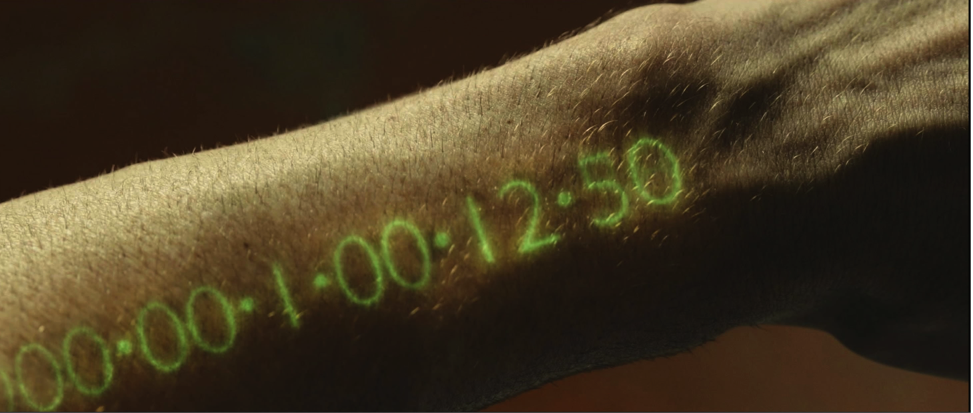
Card from the movie “Time”: when our new tablets were received, our employees immediately remembered something similar.
A lot of problems were caused to us by the wired connection of the tablet and scanner: over and over again, the contacts of the unreliable mini-USB connection failed. They had to be replaced (tablets more than once visited the service center - they changed either the connector or the entire tablet). As a result, we had to refuse uncomfortable and unreliable tablets and wired scanners - we replaced them with more compact Highscreen Boost smartphones (4.3 '', Android OS, 4160 mAh), which were supplemented with a Bluetooth scanner (made by Chinese OEM).
The advantage of this option is that, firstly, this relatively inexpensive phone discharges extremely slowly, and secondly, it can be easily removed in your pocket - therefore, it does not interfere when working with goods, and the Bluetooth-connected scanner does not require extra wires , works properly and also does not hinder the employee’s movements (scanners, in addition to everything else, come with a cover that allows you to attach them to the phone’s body, so that if necessary, these two devices can work as a whole). Let's say right away: we had the idea of transferring employees to iPads, we refused it because far from every wireless (and not a single wired) scanner can connect to them.
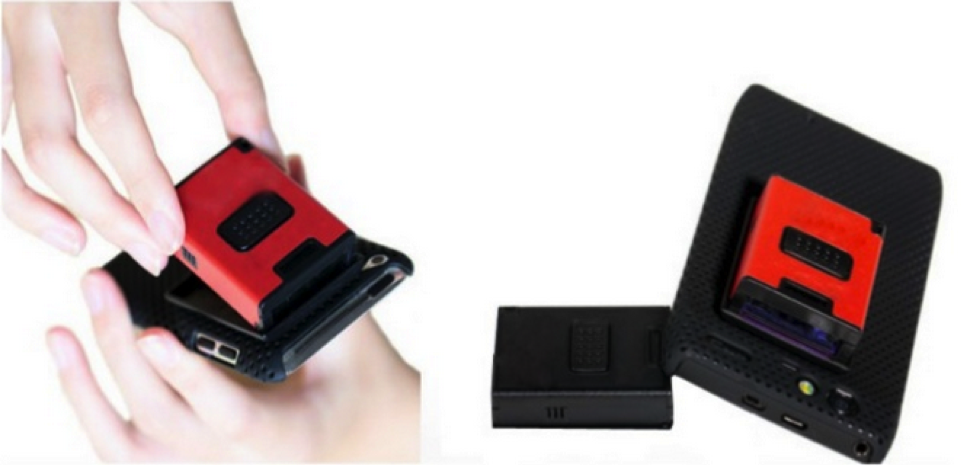
It looks like new equipment for warehouse workers
The subtleties of this stage were precisely the selection of the uninterruptedly working combination “tablet / smartphone-scanner”, which we ultimately found: if you select the right kit, processing the data received from the Bluetooth scanner for the phone will not be a problem - it recognizes them as information entered from the keyboard (therefore, it is not necessary to write any additional drivers, and even less so). During operation, the devices are not confused and are not lost - at night, employees leave them to be charged in individual cells provided for joint storage of the phone and the scanner. Sets of devices are not tied to a specific employee - at the beginning of the day, an employee can take any set, scan his badge (thus logging in to the system) and get to work.
Our warehouse software works through the smartphone’s browser - this is where all the hints and instructions from the system about what goods to pick up appear (then the employee has to find and scan them, the system will not allow you to pick up the wrong product). Thanks to this, the solution turned out to be quite flexible: if for one reason or another it turns out that the current hardware of the storekeepers is not convenient enough, it will not be difficult to switch to another type of device.
Reception of applications for assembly is also automated. To receive tasks at the first stage of the warehouse reorganization process, employees used a warehouse monitor - a screen from which the scanner could read information about what goods should be collected.
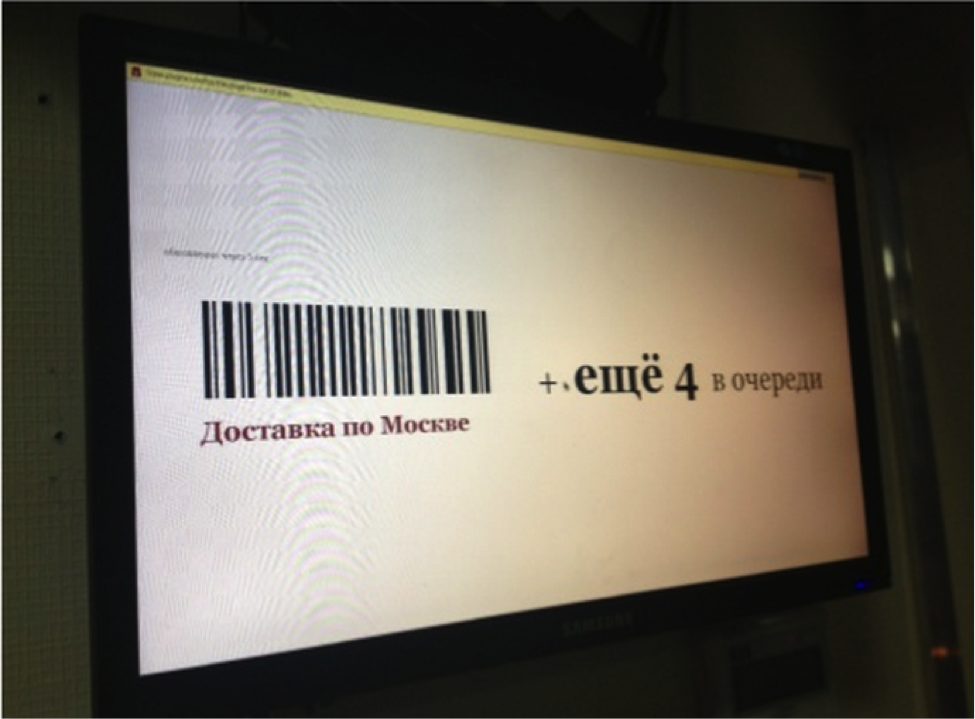
The first stage of the reorganization: a monitor showing a barcode of the highest priority assembly at the moment
For all its manufacturability, we decided to simplify this approach: since the warehouse has a single queue for assembling orders, there is no need to dynamically change the barcode with information about the new assembly. Now we use a single barcode for everyone (printed on paper) - scanning it, the storekeeper simply confirms that he is ready to process the next order in the queue, the details of which are already sent directly to the employee’s smartphone. This decision was dictated not only by the desire to simplify the process: it turned out that the wireless scanners we purchased did not read information from the monitor screen. And although the monitor is no longer used for this task, we continue to successfully use it in the warehouse: now it displays statistics on the status and characteristics of orders in the queue.
The system generates and prioritizes assemblies automatically, changing their order if necessary. Wherein:
- Retail customers are always a priority (this rule is relevant for those premises in which the retail space is adjacent to the warehouse - in our case, this is the central store at the metro station Elektrozavodskaya, where all the innovations were rolled in. Now the developed approaches are also applied in a large warehouse of 1000 sq.m.).
- When forming sets of goods for delivery in Moscow, we adapt to the situation. At the same time, we collect orders only a day in advance (no more), since less urgent orders receive lower priority.
- Regional dispatches to various companies are usually tied to a specific time, since transport company employees arrive at the warehouse at a pre-selected hour (in this case, the assembly priority is higher, the closer the appointed X hour - and after that the priority of this type of assembly decreases).
- Despite the fact that all decisions on the priority of assemblies are made by the system, the warehouse manager can adjust its actions if, for example, couriers or representatives of the transport company are late by the due date.
[ About how the “physical” organization of warehouse logic and the whole system as a whole looks from the user's point of view, about the conclusions and results of the reorganization we are in Part 2 ]
